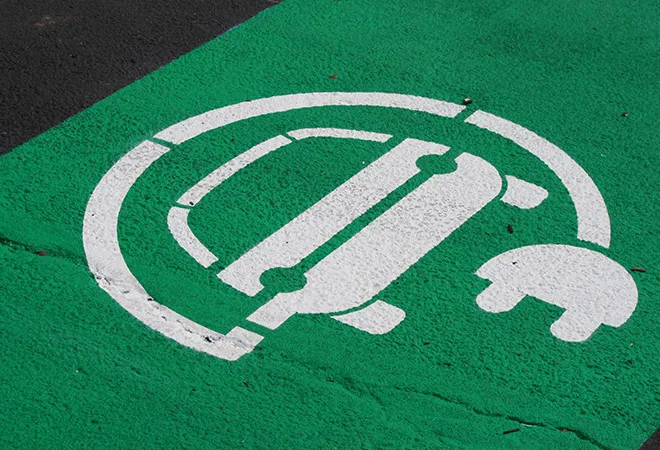
Lithium-ion Battery (LIB) plays a significant role in our daily lives. Their usage is omnipresent in most rechargeable electronic devices like phones, tablets, laptops, etc. However, the environmental impact of LIB disposal, which is a reactive alkali metal, remains a major concern. With the absence of necessary disposable mechanism, most spent LIBs end up in landfills. This results in contaminating the said land, rendering it useless and harmful for the local ecosystem. LIBs consist of transition metal oxides or phosphates, aluminum, copper, graphite, organic electrolytes with harmful lithium salts, polymer separators, and plastic or metallic cases. Increasing disposal of portable batteries has contributed to a significant increase in waste from electronic and electrical equipment (WEEE); this waste contains highly toxic substances which eventually re-enters the environment when dumped into the landfill.
Not only is the erroneous disposal of LIBs an environmental concern, it is also a wasted economic opportunity. Approximately 70 percent of the hazardous waste in a landfill comes from e-waste which is approximately worth $62.5 billion. Recycling LIBs can reduce energy consumption and curb wastage of natural resources. Particularly for LIBs, the economic opportunity is even more prominent. Currently, the automobile sector is primarily dependent on China, Taiwan, and Japan for the import of lithium-cells with only assembling (cell to pack), taking place in India.
Not only is the erroneous disposal of LIBs an environmental concern, it is also a wasted economic opportunity.
The government has bet big bucks on localised manufacture of Lithium-ion-cells, which aims to significantly reduce the cost of electric vehicles (EV) and provide better output in local conditions. However, procurement of the necessary resources for manufacture stares at an imaginable crisis or cost fluctuations, primarily, due to uncertain geopolitical complexities. In a statement issued by the Indian mines ministry: “Amongst identified strategic minerals, which have meager resource base, lithium and cobalt are significant. They will help in building partnerships with other mineral-rich countries like Australia and those in Africa and South America.”
LIB recycling offers an effective opportunity to ensure swift disposal and uninterrupted supply of rare battery-grade materials. The recycling challenge looms globally as well, over eleven million tonnes of spent LIBs that need to be discarded by 2030, but very few recycling units are in place to enable recycling. For example, according to a study by CSIRO currently, only two percent of 3,300 tonnes of LIBs are being recycled in Australia. This figure is expected to exceed up to 100,000 tonnes by 2036. The study also suggests that with efficient recycling 95 percent of battery components could be used to manufacture new LIBs or used in other industries.
Challenges for local recycling
As a potential green transport revolution is on the verge of fruition, scaling demand for LIBs has afforded lithium as a prized commodity around the globe, exposing the Indian sector to compete with an established supply chain order. Gaining access to lithium and cobalt reserves is a tricky task since they are concentrated in a few geographies. The Minister of State from the Ministry of Environment, Forest and Climate Change opined the importance of the recycling technology to recover precious metals and the harmful effect of unregulated disposal.
Scaling demand for LIBs has afforded lithium as a prized commodity around the globe, exposing the Indian sector to compete with an established supply chain order.
As a result of an increase in lithium’s demand, the price of a LIB has decreased with the introduction of cost-effective battery-tech but the cost of lithium and cobalt is on the rise. This can be attributed to the rare occurrence of lithium primarily in Chile, Argentina, and Bolivia but a bigger problem is posed by lack of naturally occurring cobalt, which is predominantly found in the Democratic Republic of Congo. The enrichment of both resources is monopolised by China. This remains an unavoidable geopolitical complexity — China is bound to play a key role through its deeprooted supply chains.
Further, multiple states and private companies have announced aggressive targets for EV adoption, that requires significant upscaling supply chains for procurement of battery-grade materials. The global demand for Cobalt is expected to increase 11 times and lithium demand by three times between 2015 and 2025. India’s desire to be in a position of global leadership in the EV sector is met with various uphill challenges in manufacture, energy, and e-waste sectors. Indian companies not only face significant competition from emerging EV markets across the world, but existing developed markets like Norway, China, and the US. These monopolies are much higher up the value chain with conducive ecosystems and reinforced policies.
The source of materials for manufacturing LIBs is already being derived from spent, recovered, and recycled battery cells. Multiple benefits accrue by institutionalising the recycling sector, like — employment generation, lesser import bills for priced commodities, reduction of LIB’s carbon footprint, formalising e-waste segregation, and adopting a circular economy model. A recycling model will also encourage closing the loop of materials by designing better components, reusing these rare metals for the benefit of the sector, and innovations to stimulate higher recovery rates. Recycled metals are also energy efficient by 2-10 times and the mining of discarded high-tech products yields eight percent less carbon dioxide emissions.
A recycling model will also encourage closing the loop of materials by designing better components, reusing these rare metals for the benefit of the sector, and innovations to stimulate higher recovery rates.
Currently, only high-value metals are recycled and not the entire batteries. According to Dr. Gavin Harper (Faraday Institution’s lithium recycling project): “Manufacturers are secretive about their battery chemistries resulting in accidents or material wastage at recycling plants.” An end-of-life battery necessitates technological knowhow to recover key raw materials. Improper handling of battery waste can result in loss of valuable raw materials, almost no rare earth minerals are extracted from the current informal recycling model. For example, the total recovery rate for cobalt is only 30 percent whereas if appropriate technology is used recycle rate could go up to 95 percent. European Union and China have already addressed these challenges by codifying legislation to make carmakers responsible for recycling batteries. The World Economic Forum has initiated the Global Battery Alliance a public-private partnership that aims to create a sustainable battery value chain by addressing these challenges.
Inadequate and ineffective regulations
The arrival of EVs in India offers a unique opportunity for the e-waste sector and it must be addressed at this opportune moment. Otherwise, it can pose environmental and economic challenges in the future. The Battery Guidelines (2001) remain silent on LIBs, lacking any regulatory and policy framework.
Similar to LIBs, lead-acid batteries have a significant environmental impact and are illegal to not recycle in India. Although, lead-acid battery has higher toxicity the recycling process is highly recommended for both. Even after 18 years of enforcement, the Batteries Rules (2001), recycling lead-acid battery remains a herculean task with minimal application and assistance received by recyclers. Battery collection is often overtaken by unregistered recycling units that dispose of the acid openly, without treating it resulting in pollution. The wastage of lead material also leads to higher import bills. This issue is aggravated by the of lack data collection from manufacturers, collectors, and recyclers. Data collection and its analysis is of utmost importance to navigate desired changes, levy fines, and punish unauthorised smelting. Even the indistinguishable look of LIBs has often deceived recyclers and resulted in accidents at lead-acid recycle plants. Although, globally the lead-acid battery recycling is easier and profitable with standardised battery chemistry to enable easy disassembly and simple recycling process.
Data collection and its analysis is of utmost importance to navigate desired changes, levy fines, and punish unauthorised smelting.
A clear-cut guideline for collection, storage, transportation, and recycling of spent LIBs is rewarding. A research by JMK identified an exponential increase in the Indian LIB recycle market from 2.9 GWh in 2018 to about 800 GWh by 2030, estimating a $1,000 million opportunity by 2030. A few companies are already on board, like the Tata Chemicals and MG Motor-Umicore collaboration, plan to set up LIB recycling units. Legislative backing and incentives are imperative to formalise and promote LIB recycling units in India. The policy gap must be addressed through capacity building now to lead LIB recycling in the future.
Suggestions
The competitive market forces should be kept in mind while formulating a policy on LIB recycling. Incentivising and promoting early-stage partnerships with research programmes for carmakers and recyclers is the key.
i. Small-scale recycling plants could be set up as pilot projects, in proximity to vehicle manufacturers either by a specialised recycler or the manufacturers themselves. To ensure a good recovery rate and reduction of secondary pollution without compromising battery-grade materials. Importing end-of-life LIBs, especially from countries without recycling guidelines can also generate a necessary stimulus to initiate basic research and development in the pilot projects.
ii. The regulatory bodies that monitor environmental impacts are understaffed and the finance received by them remains inadequate. Employees in these regulatory bodies lack technical knowhow and legal understanding to discharge their duties, hence regulatory authorities must incentivise awareness to ensure compliance.
iii. With the co-existence of EVs and Internal Combustion Engine (ICE), ICE’s should also be brought under the purview of formalised recycling. An ICE engine composes of various chemicals, plastics, and metal components. Recycled ICEs have proven to be good energy sources to replace fossil fuels for manufacture, but currently, the recovery rates remain low.
iv. The recycling rate must be improved by imparting awareness about segregation and disposal after battery/engine usage is complete — both industrially and locally. The innovation potential is massive for the separation technology for recovered cells as mixed techniques of extraction can curb resource wastage.
The opportunity at hand is threefold — to create skilled jobs in recycling units, curb environmental implications of dumping and ensure a positive effect on resources. Although, uninterrupted cobalt/lithium supply is based on the number of batteries recycled. Recycling itself cannot provide a significant supply imminently, as the demand for EVs remains nominal. Currently, the techniques to disintegrate a battery for recovery are energy consuming with low-cost returns, if done on a small-scale. Hence, fiscal and non-fiscal incentives with phased policy interventions are essential for attainable environmental and economic benefits. Careless dumping of Li-ion batteries and ICEs, coupled with usage of coal-based electricity will continue to harm the environment even after EV adoption. This can render the EV policy a problem-solution mismatch wherein the environment is still exposed to risks of GHG emissions and results in wastage of resources. To mitigate this effect, recycling LIBs is an excellent opportunity.
The views expressed above belong to the author(s). ORF research and analyses now available on Telegram! Click here to access our curated content — blogs, longforms and interviews.




 PREV
PREV


